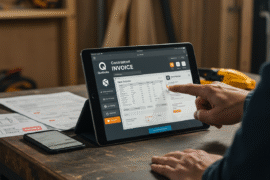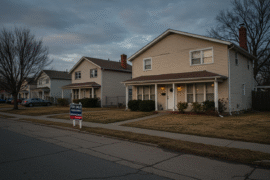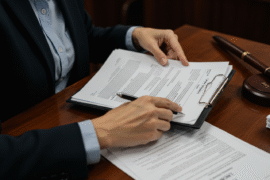This article may contain references to products or services from one or more of our advertisers or partners. We may receive compensation when you click on links to those products or services. Nonetheless, our opinions are our own.
The information presented in this article is accurate to the best of our knowledge at the time of publication. However, information is subject to change, and no guarantees are made about the continued accuracy or completeness of this content after its publication date.
Experiencing identity theft can feel like a direct threat to your financial stability and personal safety. Many people experience the aftermath of identity theft each year. It might seem challenging, but there are specific steps you can follow to improve your credit and manage your finances effectively. We’ll provide a simple, step-by-step guide to help you fix your credit after identity theft. You have the right to feel safe and confident as you work to rebuild your financial standing, and we’re here to offer the support you need to achieve that.
- How Identity Theft Affects Your Credit Score
- Taking Immediate Action to Report Identity Theft
- Look at Your Credit Reports for Any Unauthorized Activity
- Disputing Fake Accounts and Charges Effectively
- Establishing a Credit Recovery Plan for the Future
- Using Resources and Support Systems to Improve Your Credit
- What Is a Security Freeze?
- How to Freeze Your Credit
- Frequently Asked Questions
- Recommended Reads
How Identity Theft Affects Your Credit Score
Identity theft can be a deeply upsetting experience, especially when it impacts your credit score. When someone uses your personal information without permission, they might open new accounts in your name or make unauthorized charges to existing accounts. These actions can cause significant damage to your credit. You may wonder how someone else’s actions can harm your financial reputation and limit your ability to get a loan or rent a home.
It’s important to understand the potential impact on your credit:
- Higher debt-to-income ratio: Unauthorized charges increase your overall debt, affecting your debt-to-income ratio.
- Missed payments: Unpaid bills from fraudulent accounts show as missed payments on your credit report, reducing your score.
- Length of impact: Depending on the severity of the theft, recovery could take weeks or even months, adding ongoing stress and concern.
To see how identity theft can affect your credit score, review the table below:
| Action | Impact on Credit Score |
|---|---|
| Fraudulent account opened | -50 to -200 points |
| Missed payments on fraudulent accounts | -100 to -200 points |
| High credit utilization from new charges | -30 to -100 points |
Acting quickly can help you begin restoring your credit. Reporting the theft and removing fraudulent charges are essential steps in regaining your financial stability. Being informed is key in protecting yourself from identity theft.
Taking Immediate Action to Report Identity Theft
When you discover that someone has stolen your identity, it’s important to act fast. Start by contacting your bank and any other institutions where you see suspicious activity. Then, freeze your credit by reaching out to the three major credit bureaus—Experian, TransUnion, and Equifax. This will help prevent further harm by blocking new accounts from being opened in your name.
File a report with both the Federal Trade Commission (FTC) and your local police department. The FTC report becomes a formal record that supports your case when disputing fraudulent transactions. Here’s a simple checklist to follow:
- Document everything: Keep a record of all communications and reports.
- Notify creditors: Inform them of any unauthorized charges.
- Review your credit report: Look for unfamiliar accounts or inquiries.
- Follow up: Make sure all necessary fraud prevention steps are in place.
Taking these actions helps secure your financial future and gives you control during a difficult time. The road ahead may be tough, but you don’t have to face it alone.
When reviewing your credit reports, it’s important to stay alert and take immediate action. First, request your free credit reports from the three major credit bureaus: Experian, TransUnion, and Equifax. Review them carefully and look for any entries that appear unfamiliar. Focus on:
- New accounts: Identify credit accounts you didn’t open.
- Inquiries: Check for hard inquiries that don’t reflect your activity.
- Balances: Make sure reported balances match your actual accounts.
If you find any unauthorized activity, take action right away. Document what you discover and contact the appropriate creditor and credit bureau. Request a fraud alert on your credit file, and consider placing a credit freeze if necessary. Use the table below to track your steps:
| Step | Action | Status |
|---|---|---|
| Identify issues | Review credit reports | Done |
| Notify creditors | Contact companies linked to unauthorized accounts | Pending |
| Alert bureaus | Request fraud alert or freeze | Pending |
Remaining careful and consistent in this process will help protect your finances and speed up your recovery.
Disputing Fake Accounts and Charges Effectively
If you find fraudulent accounts or charges on your credit report, take immediate steps to dispute them. Begin by collecting all necessary documentation that proves the charges are not valid. This may include bank statements, letters from creditors, or messages related to the issue. Once your records are organized, file a dispute with the credit bureaus. Include:
- Your personal information: name, address, and social security number.
- A description of the fraud: Clearly explain why the account or charge isn’t yours.
- Supporting documents: Attach all relevant evidence to strengthen your case.
In addition to filing with the credit bureaus, contact the creditors directly. Provide your documentation and ask them to close the fraudulent accounts. Use the table below to keep track of your progress:
| Step | Action |
|---|---|
| 1 | Gather documentation |
| 2 | File a dispute with credit bureaus |
| 3 | Contact creditors |
| 4 | Monitor your credit report |
Keep following up on each dispute until it’s resolved. This persistence will help you limit the damage and rebuild your credit profile.
Voted "Best Overall Budgeting App" by Forbes and WSJ
Monarch Money helps you budget, track spending, set goals, and plan your financial future—all in one app.
Get 50% OFF your first year with code MONARCHVIP
Establishing a Credit Recovery Plan for the Future
To protect your financial future and repair your credit after identity theft, follow a well-structured recovery plan. Start by checking your credit reports regularly for mistakes or unauthorized accounts. You’re entitled to one free credit report each year from each of the three major credit bureaus. If you find any errors, dispute them promptly—many issues can be resolved online or over the phone.
To continue improving your credit, take the following steps:
- Engage with creditors: Talk to them about your situation. Some may offer adjusted payment plans or temporary relief.
- Set up payment reminders: Use tools like calendar alerts or autopay to make sure bills are paid on time.
- Create a budget: Focus on paying off debt while saving. A clear view of income and expenses can help. For example:
| Income | Expenses |
|---|---|
| $3,000 | $2,500 |
Also, consider signing up for a credit monitoring service. These services alert you to suspicious activity and track changes in your credit score. By following these steps, you’ll not only recover from identity theft but also build long-term financial strength.
Using Resources and Support Systems to Improve Your Credit
Rebuilding credit after identity theft can be challenging, but you don’t have to do it alone. Many helpful resources and support systems are available. Start by contacting a local consumer credit counseling agency. These professionals can provide personalized advice and help you create a plan to pay off debt and rebuild your credit.
You can also join online communities or forums where others share their experiences and advice. Learning from others can give you valuable insights and emotional support.
Make use of educational tools like:
- Federal Trade Commission (FTC): Offers step-by-step recovery guides.
- Credit bureaus: Provide free credit reports and dispute instructions.
- Financial workshops: Often available at libraries or nonprofit groups.
- Money management apps help monitor your credit and offer tailored suggestions.
Track your progress using a simple chart like this:
| Step | Status | Notes |
|---|---|---|
| Review Credit Report | Completed | Checked for inaccuracies |
| Settle Disputes | In Progress | Following up with agencies |
| Build Positive Credit | Not Started | Considering secured credit card |
With the right resources and support, you can successfully rebuild your credit and reclaim your financial freedom. Every small step moves you closer to long-term stability.
What Is a Security Freeze?
A security freeze, or credit freeze, helps protect your credit information from unauthorized access. When your credit report is frozen, it prevents new creditors from viewing it, making it harder for identity thieves to open new accounts in your name. You can lift the freeze temporarily if you need to apply for new credit.
How to Freeze Your Credit
To freeze your credit, contact each of the three major credit bureaus—Equifax, Experian, and TransUnion. You’ll need to verify your identity with personal information. Once the freeze is in place, creditors won’t be able to access your credit report without your consent. This added protection can help prevent future fraud and give you peace of mind.
Frequently Asked Questions
What should I do right after discovering identity theft?
Collect all relevant information about the unauthorized activity, including affected accounts and dates. Contact the companies or financial institutions involved to report the fraud and prevent further damage.
How can I place a fraud alert on my credit report?
Contact one of the three major credit bureaus—Experian, TransUnion, or Equifax. That bureau will notify the other two. A fraud alert requires businesses to verify your identity before granting credit in your name.
What should I do to dispute false charges?
Gather your supporting documents, such as account statements and fraud evidence. Contact your bank or credit card provider through their customer service or website and follow their process to file a formal dispute.
Should I freeze my credit? How do I do it?
Yes, freezing your credit is a strong security measure. Contact each bureau—Equifax, Experian, and TransUnion—individually to place the freeze online or by phone. Be ready to verify your identity.

Reviewed and edited by Albert Fang.
See a typo or want to suggest an edit/revision to the content? Use the contact us form to provide feedback.
At FangWallet, we value editorial integrity and open collaboration in curating quality content for readers to enjoy. Much appreciated for the assist.
Did you like our article and find it insightful? We encourage sharing the article link with family and friends to benefit as well - better yet, sharing on social media. Thank you for the support! 🍉
Article Title: How to Fix Your Credit After Identity Theft: Recover Up to 200 Points Fast
https://fangwallet.com/2025/05/27/fix-your-credit-after-identity-theft/The FangWallet Promise
FangWallet is an editorially independent resource - founded on breaking down challenging financial concepts for anyone to understand since 2014. While we adhere to editorial integrity, note that this post may contain references to products from our partners.
The FangWallet promise is always to have your best interest in mind and be transparent and honest about the financial picture.
Become an Insider

Subscribe to get a free daily budget planner printable to help get your money on track!
Make passive money the right way. No spam.
Editorial Disclaimer: The editorial content on this page is not provided by any of the companies mentioned. The opinions expressed here are the author's alone.
The content of this website is for informational purposes only and does not represent investment advice, or an offer or solicitation to buy or sell any security, investment, or product. Investors are encouraged to do their own due diligence, and, if necessary, consult professional advising before making any investment decisions. Investing involves a high degree of risk, and financial losses may occur including the potential loss of principal.
Source Citation References:
+ Inspo
There are no additional citations or references to note for this article at this time.












































